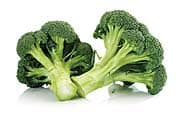Life Extension Magazine®
Chemoprevention is one of the hottest topics in oncology today. Experts define it as “a cancer-preventive strategy to inhibit, delay or reverse carcinogenesis using naturally occurring or synthetic chemical agents.”1 Scientists have known that cruciferous vegetables contain a host of chemopreventive agents that act in many different ways to block cancer development.2 Key among these products are indole-3-carbinol (I3C) and sulforaphane.1,3 In addition to these natural compounds, Life Extension® has uncovered two new anti-cancer compounds: apigenin (found in low concentrations in parsley, celery, and artichokes) and benzyl isothiocyanate (BITC), found in cruciferous vegetables. These vegetable extracts have been shown to exert broad-spectrum power to prevent cancer at each critical stage in its development. There’s persuasive evidence from large, population-based studies that higher consumption of these vegetables is associated with lower rates of various cancers, including those of the colon, prostate, lung, and breast.3-6 The cruciferous family of compounds is credited with producing many of these protective effects.7-10 And as we’ll see, some of the most recently discovered vegetable extracts such as apigenin may be even more effective.14-17 Apigenin and BITC: Complementary Cancer ProtectionCancer cells need a brisk blood supply to support their rampant growth and reproduction. Preliminary studies in vitro and in vivo have found that apigenin inhibits blood vessel growth (angiogenesis) in human ovarian cancer cells, blocking production of two main signaling molecules required to stimulate vessel growth.20,21 Scientists confirmed this effect in ovarian cancer cells, also finding that apigenin strongly inhibits cell proliferation.22
Cancer cells also need energy to support their frenetic reproductive activity. Researchers applied apigenin to human pancreatic cancer cells in culture and studied the cells’ uptake of glucose.14 Astonishingly, they found that apigenin deprived energy-hungry cancer cells of glucose to support their voracious appetites and aggressive growth. It did this by down-regulating vital glucose-transporting proteins in cancer cells. This approach could effectively starve deadly cancer cells and stop them in their tracks. Most cancers begin from genetic mutations in a single cell and require multiple stimuli to proceed to the proliferation stage with its exponential growth rate. Apigenin applied to growing pancreatic cancer cells inhibits cancer proliferation in the laboratory. It does this by modulating a variety of powerful signaling molecules that stimulate proliferation, potentially blocking development of a full-blown tumor from an early-stage colony of cancer cells.15,22 Apigenin blocks proliferation of human ovarian cancer cells by a still different mechanism.23 Chemical carcinogens as well as various infections can trigger inflammation that can lead a cell to turn cancerous, and can promote tumor growth once established. Recent research demonstrates that apigenin protects pancreatic cells from damage induced by the inflammatory cytokine NF-kappaB.24 Apigenin was shown to block the autoimmune inflammation that precedes lupus and other autoimmune conditions.25 Apigenin has myriad other cancer-preventing or cancer-blocking capabilities, some of which we are only just beginning to understand. For instance, apigenin stimulates the programmed death of cancer cells, known as apoptosis, shrinking existing tumors and — again — potentially preventing tumor development in the first place.26,27 And apigenin inhibits ovarian cancer metastases in laboratory animals by preventing formation of a protein cancer cells need to invade healthy tissue.28 The best direct evidence that all these molecular effects truly help prevent cancer comes from a 2009 study by researchers at Harvard’s prestigious Channing Laboratory in Boston. Scientists found that among five common dietary flavonoids, only intake of apigenin was associated with a significant reduction in cancer risk.29 We now know enough about apigenin to recommend it as part of a general cancer chemopreventive regimen, where its effects can complement and add to those of established cruciferous vegetable components such as I3C. Interestingly, the Life Extension Foundation® discovered and published articles about apigenin’s remarkable cancer-preventing properties in 1985. At the time, regrettably, there was not a reliable source of apigenin for use in dietary supplements. BITC
Another cruciferous vegetable component receiving rave reviews is the sulfur-containing molecule benzyl isothiocyanate, or BITC (pronounced “bitsy”). As with apigenin, population studies have shown that higher intakes of BITC correlate with reduced risk of cancers of the lung, breast, and colon30 while blocking cancer development in a host of different ways. BITC induces breast cancer cell death by apoptosis (programmed cell death), interfering with cancer cells’ energy utilization and causing them to die off before they can contribute to tumor growth.31,32 In human ovarian cancer cells, BITC induces apoptosis by a different mechanism. It stimulates “signaling” molecules that tell cancer cells it’s time to close up shop.16,17,33,34 Cancer cells, like healthy tissue, must go through a complicated series of steps called the cell cycle in order to reproduce. BITC is able to shut down, or arrest, the cell cycle, preventing further cancer cells from replicating, triggering death of the cell and preventing tumor formation.35 It does this without harming normal cells. Researchers have shown that human breast cancer cells are much more susceptible to cell cycle arrest than are healthy breast cells, making BITC potentially less harmful than chemotherapy drugs that damage healthy tissues as well as cancerous ones.8 The recent finding that BITC exerts these effects as well in deadly pancreatic cancer cells is offering new hope for preventing this otherwise lethal form of cancer.36 Researchers recently discovered a remarkable effect of BITC in arresting the cell cycle and inducing cancer cell death.37 They found that BITC binds directly to various proteins in the cell, particularly tubulin, a muscle-like intracellular protein that is essential to cell division.38-40 By impairing tubulin function, BITC effectively prevents cancer cells from growing and replicating.
Many dietary and environmental carcinogens must be “activated” by enzymes in the body before they can exert their dangerous effects. Blocking those enzymes, therefore, can prevent cancer. Acting in a fashion similar to that of I3C, but by different mechanisms, BITC efficiently inhibits several cancer-promoting cytochrome enzymes, helping to prevent carcinogenesis.41 For humans concerned about preventing cancer, BITC has been shown to be most effective when it is present before or during exposure to a carcinogen.10 BITC reduces the expression of cancer-promoting estrogen receptors in breast cancer cells, for example, potentially rendering them more cancer-resistant.7 Remarkably and of great importance for those unfortunate enough to develop pancreatic cancer, BITC sensitizes human pancreatic cells to radiation therapy, potentially increasing its effectiveness and decreasing the dose of dangerous radiation required.42 And paradoxically, in pancreatic cancer cells BITC increases production of reactive oxygen species, contributing to destruction of cancerous cells.43 Other cruciferous vegetable extracts have become well-known in chemopreventive science for their remarkable ability to “switch on” protective genes while “switching off” factors that contribute to inflammation and cancer formation.2 Several vegetable extracts, particularly indole-3-carbinol (I3C), are especially effective at blocking activation of carcinogens from our diets and environment while simultaneously promoting detoxification of those and other carcinogens.1,9,19,30 I3C itself is converted in the stomach into a compound known as diindolylmethane, or DIM, which many scientists now believe is responsible for many of I3C’s beneficial effects.44 DIM can complement the activity of I3C by providing benefits at other levels in the complex cascade of cancer development. DIM contributes to cancer protection at multiple levels. For example, DIM promotes production of the potent intrinsic immune regulatory molecule interferon gamma in human breast cancer cells.45,46 DIM can also help prevent growth and development of blood vessels required to nourish cancer tumors, potentially depriving them of oxygen and nutrients before they develop into full-blown cancer. This process, called angiogenesis, has been the target of intensive research by oncologists seeking to intervene in as many ways as possible in a strategy called multifocal angiostatic therapy.47 Numerous laboratory and animal studies have established DIM’s astonishing potency at blocking angiogenesis by shutting down a variety of molecular signaling systems, depriving nascent tumors of their supplies of oxygen and nutrients.48-52 Finally, DIM, like many other cruciferous vegetable components, dramatically increases the rate of apoptosis, or programmed cell death, in prostate and breast cancer cells.53-56 Apoptosis is a powerful means by which cancers involute, or self-destruct, even before they can become apparent. What’s really exciting researchers in 2009 about all this is that DIM is showing complementary effects with standard chemotherapy agents, even in notoriously treatment-resistant tumors such as pancreatic and certain forms of lung cancer.57-60 SulforaphaneSulforaphane is another well-known cancer-preventing product of the digestion of cruciferous vegetables.61 Sulforaphane demonstrates both anticarcinogenic and anticancer activities — that is, it not only prevents cancers from developing, but may also fight cancers once they do become established.62 Sulforaphane, like the other cruciferous extracts previously discussed, controls many cancer-related events, including detoxification of potential carcinogens, promoting apoptosis, blocking the cell cycle that’s required for cancer cell replication, preventing tumor invasion into healthy tissue, and battling metastasis.62-64 Research also shows that sulforaphane is among the plant chemicals most potently capable of blocking the cancer-producing effects of ultraviolet radiation!65 Sulforaphane also deserves special mention for its unique ability to prevent toxin-induced cancers. Researchers studied people in the Chinese province of Qidong, where liver cancer rates among the highest in the world in part due to exposure to foods contaminated with the fungal carcinogen aflatoxin.66 Consumption of a “tea” produced from broccoli sprouts resulted in decreased urinary markers of aflatoxin-damaged DNA in subjects with high levels of sulforaphane in their urine. Remarkably, there was also a sharp reduction in another carcinogen produced from burning fuel. The researchers were struck by dramatic differences in how individuals converted the raw broccoli infusions into sulforaphane — a problem that would not be encountered in people taking a concentrated and purified sulforaphane-rich cruciferous extract. The bottom line is that a combination of cruciferous vegetable extracts — including apigenin and BITC — offers the greatest promise for the prevention of a broad array of cancers. These combinations can act at multiple stages in the complex cascade that leads to cancer. SummaryCruciferous vegetables have long been at the forefront of cancer chemoprevention. Cancers are complex and multifaceted disease states that offer opportunities for intervention through a multitude of mechanisms. Expertly formulated combinations of specific vegetable extracts provide just such multiple preventive capabilities. The proven anticarcinogenic powers of I3C — coupled with the ability of apigenin and BITC to shut down cancer cell growth and to induce cancer cell death by apoptosis — provide a natural, complementary approach that intervenes at several known steps in cancer causation. Focus on a healthy lifestyle, reduce your exposure to toxins, eat fruits and vegetables whenever possible — and boost your body’s cancer-fighting powers with the vegetable extracts that are right for you. If you have any questions on the scientific content of this article, please call a Life Extension® Wellness Specialist at 1-800-226-2370. | |||||
| References | |||||
|



